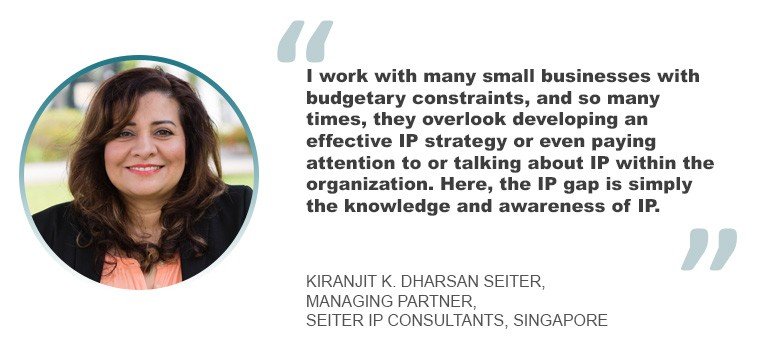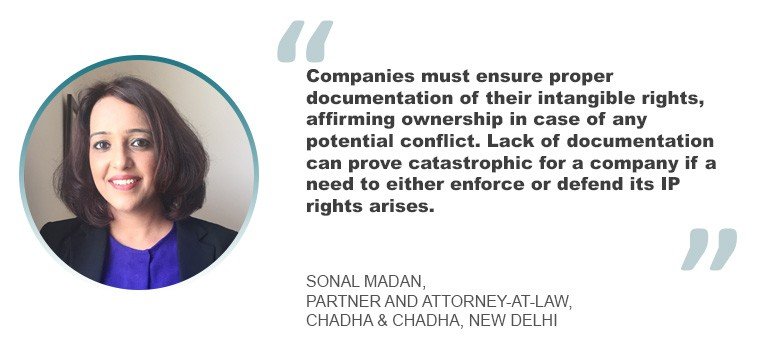How IP gaps can hamper strategy and innovation
31 October 2022

The present market landscape brings businesses to unearth strategies to differentiate themselves from competitors and affiliates. While intellectual property facilitates innovation and enables a company’s growth by providing value to its intangibles, there are times that these may be overlooked – which can exist in diligence, management, and enforcement of intellectual property rights. These could be in the form of not identifying a conflicting technology, underestimating the value of existing IP assets, not prioritizing enforcement of rights, lack of understanding of international rights in an existing IP, or not identifying security gaps.

“It needs to be kept in mind that gaps in IP protection always exist,” says Anton Blijlevens, a principal at AJ Park in Wellington. “It’s not necessarily a bad thing because a patch work of IP protection can have a net synergistic effect. Gaps arise sometimes intentionally due to budget constraints. However, IP gaps are most often overlooked gaps. And this can be a bad thing.”
This “bad thing” may come in the form of a competitor entering the market and competing quickly and successfully. This may also come in the form of early stage companies where their entire business is dependent on one or two key pieces of IP. Such companies are typically not sufficiently capitalized to be able to afford gaps in their protection. They are often seen as the external R&D division for “us-too” competitor companies, ironing out for free all the technology and market validation wrinkles in a new concept or venture. If they are lucky, they may get acquired by such me-too companies, but if they are unlucky, they will be broadsided and may not last for long.
“Landscape and prior art searching can provide a lot of really valuable information about existing technology and existing market players at a global level,” he says. “Unfortunately, companies often skip prior art searching and launch straight into filing a patent application for what they believe will be a very broad novel concept. They end up resting on their laurels, feeling a sense of security around owning a pending patent for the board concept, and hence fail to file patents for downstream improvements. This will create dangerous overlooked gaps in their IP. Often, it’s the downstream developments where the really valuable, albeit narrower, patent protection resides.”
He adds: “Such downstream developments are then not protected and when the core patent falls over because the prior art turns out to be all over it, they are left with no IP protection at all, basically making all their IP available for free to their competitors.”

Not talking enough about IP
Kiranjit K. Dharsan Seiter, a managing partner at Seiter IP Consultants in Singapore, says that it is highly important that organizations should discuss more and more about IP within their circle.
“I work with many small businesses with budgetary constraints, and so many times, they overlook developing an effective IP strategy or even paying attention to or talking about IP within the organization,” she says. “Here, besides finances, the IP gap is simply the knowledge and awareness of IP. Striking a balance between investing and spending is a difficult but necessary one. Larger corporations and multinational corporations have the advantage of stability and annual budgets for IP but for smaller businesses, it’s a question of survival. The idea that IP might be a brilliant one but without the finances and right guidance, and the foresight of IP, success can be out of reach – only a dim light with high chances of fading away rather than burning strong in a competitive world.”
And, she adds, that sometimes, the focus is on sales and marketing as opposed to investing time and money on developing a viable IP strategy. This includes identifying new and potential competitors, having a competent IP division or the right people to foresee potential threats and liabilities.
“The key here is to devote time and money into implementing a well-thought and iron-clad IP strategy at the infancy stage of the business, and engaging the right people with the requisite experience and expertise to spearhead and steer the IP strategy within the company on the right course,” she says.

Restoring overlooked IP Gaps
Meanwhile, Wiramrudee Mokkhavesa, a partner at Tilleke & Gibbins in Bangkok, gives a specific case in her jurisdiction where there were no IP protection clauses in an employment contract used by a company.
“A former employee of the company had used his copyrighted work while he was an employee of the company to promote his services to his potential clients, making the clients become confused that this former employee’s current works are related to the company,” she says. “Even this case did not directly affect the innovation strategy of the company, but anyhow greatly affected the firm’s reputation. Fortunately, that case was settled through a negotiation. The former employee agreed to stop promoting these copyrighted works. This case showed that overlooked IP gaps can greatly affect the company, including the company’s innovation strategy and reputation; and therefore, it is crucial for the IP owners to restore these gaps.”

Strategy and legal risks
In terms of business expansion, companies must be careful in protecting their IP assets in the appropriate jurisdictions. Considering the costs involved in seeking protection in multiple countries, understanding the IP protection process, access to market information, and budget management are vital to leveraging a company's IP assets.
However, gaps in IP strategy can prove to be counter-productive to a company's growth while jeopardizing product development and leading to potential legal risks.
“Companies must ensure proper documentation of their intangible rights, affirming ownership in case of any potential conflict,” Sonal Madan, a partner and attorney-at-law at Chadha & Chadha in New Delhi. “Lack of documentation can prove catastrophic for a company if a need to either enforce or defend its IP rights arises.”
These oversights mean businesses may risk losing or under-utilizing the value of their IP portfolio or, worse, exposing themselves to emerging threats. Specifically, concerning R&D and innovation, companies must conduct a detailed patent analysis to identify opportunities for licensing the technology and potential infringement issues. Madan says that if an IP is unprotected, competitors can easily duplicate the technology, process, or innovation to gain a competitive edge. In this way, rival companies can capture a more significant portion of the market share, hampering business growth.
In some cases, where IP assets are not protected, the company may be restricted from using its own invention in case competitors are able to protect it before them. Therefore, timely IP protection is critical for business growth.
“In analyzing portfolios, there should be taking necessary enforcement actions, and applying for rights in case of unprotected IP,” she says. “These diagnostic measures can enable companies to minimize the impairment of the value of their intangibles caused due to lack of IP diligence. Some of the ways in which companies mitigate the devaluation of their IP assets due to a lack of prior diligence include technology transfer and brand licensing. Apart from monetizing the existing IP assets, this could also be a tool to spread the cost and risks associated with developing and distributing a product.”
She adds: “Moreover, once the companies are able to identify gaps in their existing IP strategies, they may enter into collaborations, including joint ventures, strategic partnerships, among others. These alliances can enable companies to increase capital and other resources to grow their existing IP assets. For expansion, companies can also enter into co-branding agreements with other companies to augment the strength of an existing brand. These are some of the measures companies can take depending on the severity of damage to their existing IP due to a lack of strategic management.”
Tips for restoring overlooked IP gaps
Wiramrudee Mokkhavesa, a partner at Tilleke & Gibbins in Bangkok, provides several tips to successfully restore your overlooked IP gaps:
Take an initial inventory. Knowing what intellectual property you have, what your IPRs are worth, how your IPRs are protected, and how they should be protected will help you gain the maximum value from your creations and developments. This can be difficult for a new venture, which may not know much about IP law and the scope of IP protections. At this first stage, you may need to consult with your company’s legal advisor. Then, you can evaluate the IPRs within the company’s broader portfolio of assets and can set the proper measures to manage them.
Ensure compliance. By obtaining full protection of your IPRs under the law, you can ensure compliance while also contributing to your company’s bottom line. For example, if you create a new trademark or brand, you should register the trademark or brand with the DIP. If you come up with a unique idea or invention, obtaining patent protection will give you the exclusive right over the invention and prevent unauthorized use by your competitors. Your company may consider recording copyrighted works with your jurisdiction’s intellectual property office to easily prove the company’s IPRs in the future.
Without the proper protection, some intellectual property may be walking right out the company’s door through employees, former employees, or visitors who are using email, data storage devices, the telephone, or just taking things home. Today’s employees may be tomorrow’s competitors.
Create an IP portfolio. After initially managing your IPRs, collecting and keeping evidence to prove that your company is the true owner of these IPRs is necessary so that you will be prepared in the event of any infringement or opposition in the future. Trademark owners should collect documents demonstrating the use of the trademark in their jurisdiction, such as advertisements, invoices showing sales figures of the mark, etc., to prove the well-known status of the mark, if that status is available in the jurisdiction. It is also crucial to manage the deadline or expiration date for each of your IPR registrations to ensure timely payment of annuity fees or renewal fees.
Enforce and exploit rights. Monitoring and enforcing your IPRs is also essential because the more popular your products become, the higher the chance that your IPRs will be infringed. If you learn that a competitor has infringed your IPRs, you should enforce your rights through the relevant government authorities, such as through raid actions against infringers or by administrative methods like sending a cease-and-desist letter or mediation through your jurisdiction’s IP office.
“By taking the simple steps outlined above, you can ensure that your IPRs are well-protected, which in turn will set a strong foundation for future innovation, faster growth, and improved profitability,” she says.
– EXCEL V. DYQUIANGCO






